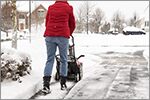Snow Thrower Usage: Keep Safety in Mind This Winter, Get Ready Before the Snow Flies

Outdoor Power Equipment Institute encourages users to ready their snow throwers for wintry weather and to review safe operating procedures
Alexandria, Va. – In an unusually early winter season, large sections of the country have already experienced snow, ice and inclement weather, and the Outdoor Power Equipment Institute (OPEI encourages home and business owners to ready their snow throwers and other winter equipment. Clearing driveways, sidewalks and parking lots is no small job. You rely on your outdoor power equipment to make snow removal easy, but it’s also important to keep safety in mind when using snow throwers, often referred to as snow blowers.
“If you’re anticipating bad weather or snow, start the machine and makes sure it operates before you need it and before repair shops are busy,” says OPEI President and CEO Kris Kiser. “Gas stations also can close and roads can be treacherous during a winter storm. You want to protect your power by having the right and fresh fuel on hand for your equipment. And, remember, gasoline-powered snow throwers should use E10 or less.”
OPEI offers the following questions to help you ready your snow thrower for the winter season:
GETTING READY
Have you read your owner’s manual? Read up on safe handling procedures. Review how to operate the controls. You should be able to shut off your equipment quickly. If you lost your manual, you can look it up online, and store a copy on your computer so you have the manual available to reference in the future.
Have you checked your equipment since storing it? Make sure all equipment is completely powered off when checking it over. If you forgot to drain the fuel last winter before storing your snow thrower, drain the gas tank now. Adjust any cables and check the auger when the equipment is powered off.
Is your equipment where you can get to it easily? Move your equipment to a convenient and accessible location, so you can get to it quickly when you need it.
Have you purchased the right fuel? Be sure to use the correct fuel, as recommended by your equipment’s manufacturer. Place gasoline in a fuel container and label it with the date purchased and the ethanol content of the fuel. Use fresh fuel in your snow thrower as fuel that is more than 30 days old can phase separate and cause operating problems. Make sure fuel is stored safely and out of the reach of children. For more information on fueling properly see www.LookBeforeYouPump.com.
Are you fueling safely? Before you start the engine, fill up the fuel tank on your snow thrower while the engine is cold and outside your home or garage. Never add fuel to a running or hot engine.
Are batteries charged? If using a battery/electric-powered snow-thrower, make sure batteries are fully charged, in case electricity goes out during a winter storm.
Is the area you intend to clear free of obstructions or hidden obstacles? Snow can hide objects. Doormats, hoses, balls, toys, boards, wires, and other debris should be removed from the areas you intend to clear. When run over by a snow thrower, these objects may harm the machine or people.
Are you dressed properly for winter weather? Locate your safety gear now, and place it in an accessible closet or location in your home. Plan to wear safety glasses, gloves and footwear that can handle cold and slippery surfaces.
OPERATING SNOW THROWERS SAFELY
Do you have a clean out tool or stick? NEVER put your hands inside the auger or chute. Use a clean out tool (or stick) to unclog snow or debris from your snow thrower.
Do you turn off your snow thrower if you need to clear a clog? Always turn off your snow thrower and wait for all moving parts to come to a complete stop before clearing any clogs or debris.
Do you use your snow thrower in visible conditions? Never operate the snow thrower without good visibility or light.
Can you aim your snow thrower with care? Never throw snow toward people or cars. Do not allow anyone to stand in front of your snow thrower. Keep children or pets away from your snow thrower when it is operating.
Will you use extreme caution on slopes and hills? Do not attempt to clear steep slopes and use caution when changing directions on slopes or inclines.
Do you know where your cord is? Use an extension cord that is weather-resistant and designed for outdoor use. If you have an electric-powered snow thrower, be aware of where the power cord is at all times. Avoid tripping. Do not run over the power cord.
Are pets and children inside while the snow thrower is operating? Kids and pets may love to play in the white stuff, but it’s best to keep them inside your home and supervised (by someone else) while you are using your snow thrower to clear a path or driveway. Do not allow them to play in the snow as it is tossed out of the snow thrower’s chute.
About OPEI
The Outdoor Power Equipment Institute (OPEI) is an international trade association representing power equipment, small engine, utility vehicle, golf car and personal transport vehicle manufacturers and suppliers. OPEI is the advocacy voice of the industry. OPEI is managing partner of GIE+EXPO, the industry’s annual international trade show, and the creative force behind the environmental education program, TurfMutt.com. OPEI-Canada represents members on a host of issues, including recycling, emissions and other regulatory developments across the Canadian provinces.
